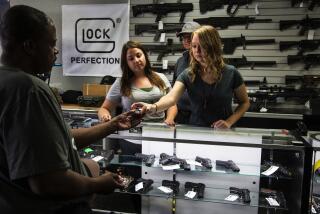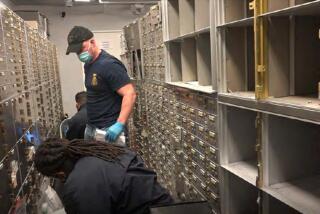Challenge to Olson Evidence Allowed
- Share via
Lawyers for accused Symbionese Liberation Army member Sara Jane Olson can challenge the admission of evidence seized in 1975 from several locations in Northern California, a judge ruled Wednesday.
Los Angeles County Superior Court Judge Larry Fidler decided that defense attorneys can argue to keep evidence including guns and bomb-making materials out of Olson’s conspiracy trial. Defense attorneys and prosecutors will present their arguments during hearings next week.
Olson, 54, called the ruling an important victory for the defense. “This gives us a little opportunity to attack their case,” she said outside court.
But a spokeswoman for the district attorney’s office said she is still confident the evidence linked to the SLA will be admitted into the trial.
Earlier this month, defense attorneys filed motions asking Fidler to exclude the evidence, saying that police officers and FBI agents failed to obtain proper warrants and conducted illegal searches. Prosecutors countered that Olson could not challenge the evidence because it was not seized from her home. Rather, the materials were taken from four other Northern California residences, a mailbox and a car that prosecutors believe were used by members of the SLA.
Fidler said Wednesday that he “tended to agree” with the prosecution’s argument, but that he had to follow previous court decisions. “As a trial court judge, I’m bound to follow existing law, whether I agree or disagree with it,” the judge said.
Fidler ruled in the defense’s favor because the searches occurred in 1975, seven years before a change in state law eased some restrictions on police searches.
In another motion heard Wednesday, prosecutors asked the judge to allow them to label the SLA a terrorist organization that posed a threat to public safety and engaged in “violent activity leading up to the contested searches.”
In response, defense attorney Shawn Chapman said the term “terrorism” should not be used in connection with the SLA. “This is a very dangerous and sensitive time in which we’re litigating the case,” she said. “The [prosecutors] are going too far.”
Attorneys are scheduled to continue discussing that issue today, with Fidler expected to make a ruling from the bench. The lawyers are also due to argue the validity of fingerprint and handwriting evidence that is expected to be presented during trial.
In addition, attorneys have yet to argue another defense motion that asks the judge to dismiss charges or order prosecutors to find and turn over a diary by former SLA associate Wendy Yoshimura. Defense attorneys say the diary could help provide an alibi for Olson.
Olson is charged with conspiring to kill Los Angeles police officers by planting bombs under two patrol cars in 1975 to avenge the deaths of SLA members in a shootout with police. Olson was arrested in Minnesota in 1999 on an indictment after more than two decades on the lam. Attorneys could begin selecting a jury for the case as early as next week. If she is convicted, Olson could face life in prison.
The prosecution plans to present evidence about alleged crimes committed by the SLA, best known for the kidnapping of newspaper heiress Patricia Hearst.
But defense attorneys have filed another motion asking Fidler to limit that evidence, as well as what prosecutors can say in opening statements and closing arguments. Chapman wrote that prosecutors would unfairly change the original 1976 indictment if they presented evidence of an SLA conspiracy to overthrow the U.S. government.
After SLA members Hearst, Bill and Emily Harris and Yoshimura were arrested in Sept. 18, 1975, the FBI conducted searches of several residences in Northern California. Agents found 200 feet of safety fuse in a rented mailbox, parts of a bomb and “a pipe attached to a battery with wire sticking out,” according to court papers.
Defense attorneys said agents did not have proper warrants when they conducted the searches. But prosecutors said in court papers that the FBI agents prepared and presented search warrants when they actually seized the evidence from two apartments in San Francisco. They also said the officers acted reasonably by entering another San Francisco residence in response to a call about a bomb. They also said a landlord allowed entry to an apartment in Sacramento.
More to Read
Sign up for Essential California
The most important California stories and recommendations in your inbox every morning.
You may occasionally receive promotional content from the Los Angeles Times.













